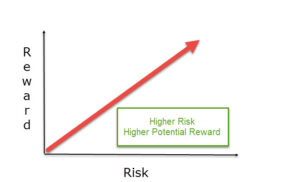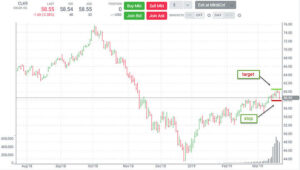Home › Market News › 5 Ways to Stop Gifting Money to the Markets – Part 3: Stop Orders and Profit Targets
The greater the risk, the greater the reward – so the theory goes. Investments that involve little risk typically offer small rewards. And high-risk trades can yield windfall profits.
In trading, risks and rewards define each position. The ratio can be tweaked using tools like stop-losses and profit targets. That’s what Part 3 of our series on Not Gifting Money to the Markets is all about.
(Note: this is the third in a five-part series. If you missed them, check out Part 1, Part 2, Part 4, and Part 5)
Money in a savings account is typically viewed as low risk, but then there is little return potential. On the other hand, buying shares of a low-priced biotechnology company could potentially result in 100% loss of one’s investment if it goes bankrupt, but there is potential for huge gains if the company makes a breakthrough discovery like a cancer drug. All investments can be plotted somewhere along a risk/reward curve like the one in Figure 1.

Figure 1: Theoretical risk/reward curve
Because risks and rewards vary from one investment to the next, it makes sense to evaluate each trade or position in terms of its possible losses versus potential gains. If, for example, a trader sells 10 futures contracts on Crude Oil, the profit is limited to the commodity falling to zero and the potential risk is unlimited because there is, theoretically, no limit to how high crude oil prices can climb.
In the real world, the risks and rewards can be adjusted in different ways. Setting a “time stop” for a trade is a simple way to limit risk. With a time stop, the trader decides to hold a position no more than one hour, whether it moves higher or lower. That’s a very strict, easy-to-follow rule that will limit both the risks and rewards of a position.
More commonly, stops are placed at prices above or below the entry price. For instance, Figure 2 shows Crude Oil at $58.55 per barrel. A trader looking to take a long position might enter a stop order just 5 cents below the previous support low of $58. So, if crude falls to $57.95, the trade is “stopped out” for a loss of 60¢ on the position.
(Note that stop-limit and stop-market orders differ in that a stop-limit specifies a specific price to buy or sell, but a stop-market will exit at the best price available after the stop is triggered.)

Figure 2: CL Futures
Tip #1: Try using brackets: with the initial order to buy or sell, the bracket includes both a stop-loss and a profit target. This automates the process of exiting the position, whether it’s a winner or loser.
Brackets allow traders to set both stops and profit targets. Returning to Figure 2, the trader expects Crude to see resistance at $60 per barrel and sets that as a target. Once the price hits $60, the long position is covered. In this example, the risk is to $57.95, or 60¢, for a potential profit of $1.45 on a move to $60. The risk/reward ratio is more than 2:1.
Tip #2: Keep a journal or Excel spreadsheet of your trades and study risk/reward ratios. If your losing trades are consistently greater than your winning trades, then, to become profitable, you will either need to 1) increase your percentage of winning trades or 2) adjust the risk/reward ratio to increase the size of the wins versus the size of the losses.
In the end, a trader’s goal is to generate profits. Risk management is important because one big loss can wipe out gains from many winning trades. That’s why Setting a Personal Loss Limit is helpful. Using stops and brackets can help set a fixed exit price while also quantifying the risk/reward of the trade.
